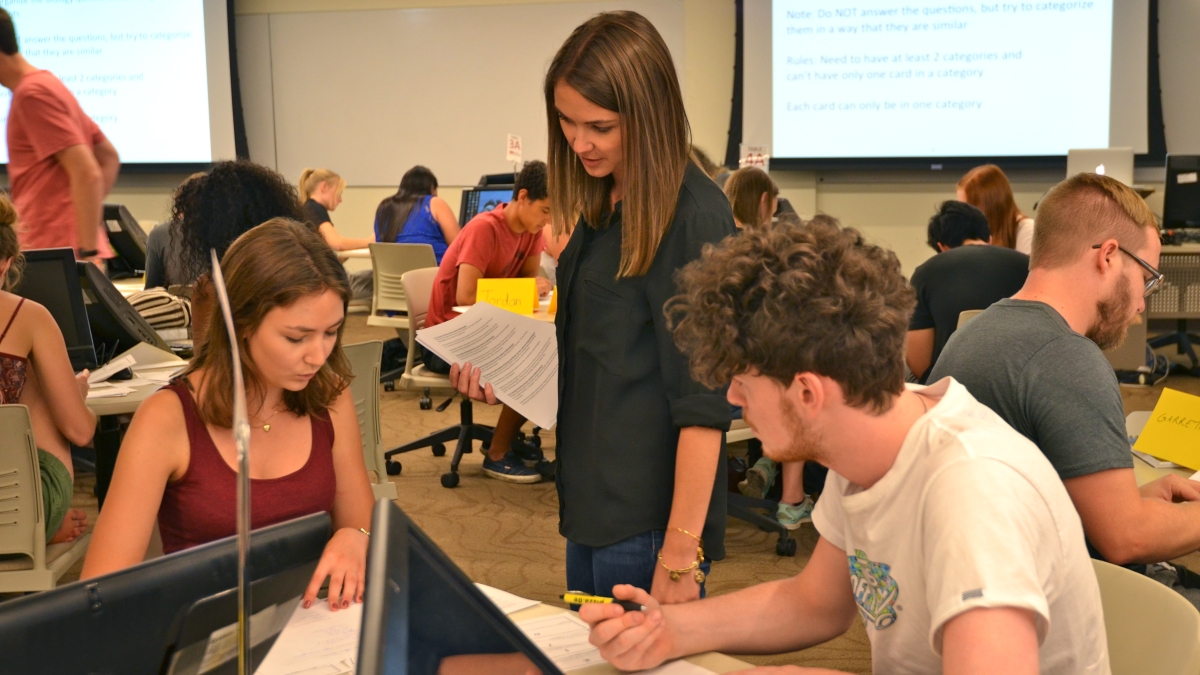‘Coming out’ in the classroom, but not by choice

An active learning biology classroom at Arizona State University. Photo by Sandra Leander/ASU
Starting out as a college freshman can be hard.
Students are leaving home for the first time, meeting the demands of a rigorous college education and trying to make new friends.
And, for undergraduate students who identify as lesbian, gay, bisexual, transgender, queer, intersex or asexual (LGBTQIA), or who may be struggling with their identity, the biology classroom may not necessarily be a welcoming place.
In a first-of-its-kind study published in the latest issue of CBE-Life Sciences Education, researchers from Arizona State University’s School of Life Sciences found that active learning classrooms, which require more group work than traditional lecture courses, may create an unaccepting atmosphere for LGBTQIA students.
“In an active learning classroom, students are asked to interact a lot with each other and the instructor,” said Katelyn Cooper, doctoral student and lead author of the study. “The students’ LGBTQIA identities are more relevant in an active learning course, particularly for transgender students who may be transitioning during the semester.”
In the U.S., 3.6 percent of people identify as LGBTQIA. For this study, seven students from a 180-person classroom were interviewed, which is similar to the national average.
“Our goal in our classrooms at Arizona State University is to be inclusive to every student, regardless of their LGBTQIA identity or any other social identity,” said Sara Brownell, assistant professor with the School of Life Sciences and senior author of the study. “The national conversation right now is to move more science classrooms into the active learning model. But as we do this, we need to be cautious how these student interactions are playing out in class. These interactions among students may impact how well these LGBTQIA students are doing in the class. This study is the first to illuminate potential challenges for these students in active learning spaces.”
Assistant professor Sara Brownell (left) and doctoral student Katelyn Cooper (right), both with the ASU School of Life Sciences, conducted a first-of-its-kind study on the active learning classroom experiences of LGBTQIA students. Photo by Sandra Leander
The researchers found that all of the students who identified as LGBTQIA struggled in some way with group work. While the students faced more opportunities to interact more closely with others, this presented more opportunities for them to have to self-identify. The researchers say this is important because oftentimes, students come out during their college years but are hesitant to do so before they’re fully ready to announce their LGBTQIA identity to the outside world.
“In a traditional lecture course, students can sit in the back of the group and be somewhat invisible,” Brownell said. “But in the interactive class, we ask them to engage with others. This is extending into conversations they don’t want to have. They have to decide, ‘Do I come out to this person I don’t know? Do I lie? Do I change the conversation?’”
Brownell’s lab studies how students learn biology in the classroom. In particular, she and her research team investigate the experiences of students with potentially underrepresented or stigmatized social identities in the classroom, including gender, race, ethnicity, religious affiliation and LGBTQIA identity.
“It has been shown that more diverse groups of people lead to better science. It’s important to make sure that our next generation of scientists is diverse, and this starts in the undergraduate classroom. Students with LGBTQIA identities can offer unique and important perspectives,” added Cooper.
The researchers do not recommend moving away from the active learning classroom. In fact, they support the active learning model as an effective way to help retain students in STEM fields and keep them engaged in challenging topics. However, they do recommend that instructors think carefully about how they structure group work and suggest they can work toward creating safe spaces for students to feel comfortable sharing their identities.
The next step for the researchers is exploring this topic at a national level and in different geographic locations to see whether students in other parts of the country have similar experiences in the active learning setting.
More Science and technology

Beyond the 'Dragon Arc': Unveiling a treasure trove of hidden stars
NASA's James Webb Space Telescope (JWST) has set a new milestone: capturing images of over 40 individual stars in a galaxy so…

ASU selected as home and partner for CHIPS and Science Act-funded national facility for semiconductor advanced packaging
Following a week where a spirited effort by the Sun Devil football team captured the nation’s attention in the Peach Bowl, it is…

ASU professor shares the science behind making successful New Year's resolutions
Making New Year’s resolutions is easy. Executing them? Not so much.But what if we're going about it all wrong? Does real change…